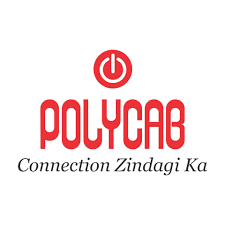
Polycab is engaged in the business of manufacturing and selling wires and cables and fast moving electrical goods (FMEG) under the POLYCAB brand. Apart from wires and cable, company manufacture and sell FMEG such as electric fan, LED lighting and luminaries, switches and switchgears, solar products and conduits, water heaters and accessories. Company was incorporated as Polycab Wire Private Limited on January 10, 1996 at Mumbai as a private limited company. Company manufacture and sell a diverse range of wires and cables and its key products in the wires and cable segment are power cables, control cables, instrumentation cables, solar cables, building wires, flexible cables, flexible/single multi core cables, communication cables and other including welding cables, submersible flat and round cables, rubber cables, overhead conductors, railway signaling cables, speciality cables and green wires. In 2009 company diversified into the engineering, procurement and construction (EPC) business, which includes the design, engineering, supply, execution and commissioning of power distribution and rural electrification projects. In 2014, company diversified into the FMEG segment and its key FMEG are electric fans, LED lighting and luminaries, switches and switchgears, water heaters, solar products and consuits and accessories. Company has 25 manufacturing facilities, including its two joint ventures with Techno and Trafigura, located across the state of Gujarat, Maharashtra and Uttarakhand and the Union territory of Daman and Diu. Wires and cables are manufactured at its Halol (Gujarat) and at Daman plant with manufacturing capacity of around 3.5 million km/year. Fans are manufactured at its Rookee (Uttarakhand) plant with manufacturing capacity of around 2.4 million units per year. Switches and switch gear are manufactured at it Nashik (Maharashtra) plant with manufacturing capacity of around 6 million units per year. Lights are manufactured at its Chhani ( Vadodara, Gujarat) plant with manufacturing capacity of around 18.2 million units per years. Copper rod and steel wire are manufactured at its Waghodia (Gujarat) plant with manufacturing capacity of around 2,25,000 MT of copper rod per year and 60,000 MT of steel wire per year. In 2016 company entered into a 50:50 joint venture with Trafigura, commodity trading company, to set up a manufacturing facility in Halol, India to produce copper wire rods ( the Ryker Plant) . Most of its manufacturing facilities are accredited with quality management system certificates for compliance with ISO 9001, ISO 14001 and OHSAS 18001 requirement. Company’s central quality and test laboratory in Halol is accredited by NABL and its central test laboratory, also located at Halol, for all flexible wires and cable wires is approved by underwriters Laboratories (UL) .Certain of its products are also certified to be compliant with various national and international quality standards including Bureau of Indian Standards (BIS), British Approvals Service for Cables (BASEC), UL and electrotechnical commission (IEC). Company have adopted automation system in its manufacturing process such as the manufacturing excellence system (MES), which is an automated sensor base system for recording the actual consumption of raw materials in production, as well as enterprise resource planning (ERP) systems. Company have also adopted the Maynard Operation Sequence Technique (MOST) to drive productivity and optimize capacity utilization. Company has an established supply chain comprising its network of authorized dealers, distributors and retailers. This network supplies company’s products across India. Its distribution network in India comprise over 3,100 authorized dealers and distributors and 29 warehouses. Company supplies its products to over 1,00,000 retail outlets in India. Company manages its sales and marketing activities through its corporate office, three regional offices and 20 local offices in various parts of India. Company exports its products to over 40 countries. India is the world’s third largest country in production of electricity. India now generates around 1,160.1 billion units of electricity in 2018, up 4.72% from the previous year. The country is behind only from China which produced 6,015 terrawatt hours and the US which produced 4,327 TWh and is ahead of Russia, Japan, Germany, and Canada. The electrical cables and wires segment constitutes 40-45% of the electrical equipment industry in India, which constitutes 8% of the manufacturing sector in terms of value, and 1.5% of the overall GDP. The increasing demand for power, light and communication has kept the demand for cables and wires high. Investment in power transmission projects, execution of solar and wind energy projects, metro rail projects, and increased household spending have all led to an increase in demand of power and building wires and cables. Growth in the industrial sector has resulted in increased demand for flexible cables and wires and control and instrumental cables. The Indian cables and wires industry has grown at a CAGR of approximately 11% in the last five years to reach Rs 525 billion in 2018. Cables and wires industry follows the trend of key raw materials prices mainly copper and aluminium. Cables and wires industry is expected to grow by approximately 15% CAGR and reach an estimated Rs 1,033 billion by fiscal 2024. Government investment focus on smart cities and metro construction in major Indian cities will drive growth for various types of cables and wires. Metro projects are to be the second largest urban infrastructure investment contributor over the next five years. Construction spend on metros to increase 1.9 times to approximately Rs 1.1 trillion over fiscal 2019-2023. The demand for electric vehicles (EV) could bring in volume uptick for companies operating in the cables and wires (C&W) segment. The critical component in EV is an electric wire harness. Compared to a conventional ICE vehicle, the requirement of the wire harness, supplied by auto component makers, is 3x in EV. However, the wire requirement in a vehicle is different and to develop such process in house would require huge capital expenditure. Hence, the wire manufacturing would be done by manufacturers in cables & wires industry. There would be an additional demand coming from setting up of EV charging infrastructure, which also requires some amount of wires. Lighting industry , comprising conventional lighting, LED lighting and accessories, is at Rs 212 billion as of fiscal 2018. The industry is estimated to has experienced approximately 10.5% CAGR over the past five years. The Indian lighting and luminaire industry will experience approximately 7% CAGR, to reach estimated market size of Rs 301 billion by fiscal 2023. India is second most populous country in the world and yet, is only the fifth largest electricity consumer, a situation that has led an ever widening demand supply gap. The market for energy efficient products such as LED lighting is bound to grow, riding on the initiative that encourage the use of LED lights, the focus on smart city projects, an efficient public distribution system and the ever increasing need for smart, connected lifestyle. Government has also taken initiatives to boost LED adoption and growing awareness regarding lower power consumption of LED lighting products. Moreover, easy availability at low prices, coupled with the distribution of LED bulbs by the Indian government at affordable rates is augmenting demand. LEDs are versatile products and can be used for residential lighting, street lighting, downlights, landscaping, monument lighting, signage, traffic signals, security lights, industrial lighting, office space lighting, automotive lighting and much more. Low energy consumption, low cost, modular designs and ease of use have made LED lighting the first choice in industrial, commercial and domestic applications. The demand for LED lighting in India is still mostly driven by metro cities due to awareness and socio- economic growth. However, the demand from Tier II, and III cities is expected to grow too, on account of the potential applications for street lighting and industrial lighting. The demand for LED lighting from the rural India is also going to increase significantly, soon due to government initiatives for implementing rural LED street lighting projects by retrofitting conventional street lights with LED lights in gram panchayats under the street lighting national project (SLNP). Further expansion of such initiatives across the country will open up the new market areas for the LED lighting industry. In near future, the revolutionary Li-Fi (light fidelity) technology can be the game changer for the LED lighting market. Li-Fi is a wireless communication technology that uses the infrared and visible light spectrum for high speed data communication. In its present state, only LED lamps can be used for the transmission of visible light. One of the biggest applications of Li-Fi could be in the upcoming smart cities in the country, where the underlying theme will be the internet of things for modern city management and the connectivity will happen through LED bulbs. Li-Fi speed can touch as much as 10GB per second over a 1km radius. Moreover, Li-Fi has the advantage of being useful in electromagnetic sensitive areas such as aircraft cabins, hospitals and nuclear power plants as it does not cause electromagnetic interference. Li-Fi is expected to be ten times cheaper than Wi-Fi . Indian railways has taken an eco- friendly step to make all railway stations 100% LED lit. India will be probably first country in the world which will be 100% using LED for its lighting needs by 2021, which would help the nation to save over Rs 40,000 crore a year. The switches industry is at Rs 40 billion as of fiscal 2018, having experienced a CAGR of approximately 8% over the past five years. Despite the impact of the real estate sector slowdown, the industry has grown in value with the increasing demand for modular switches with higher price points. The switches industry is expected to grow to Rs 62 billion by fiscal 2023 at a CAGR of approximately 9%. Switches to experience robust growth, driven by government initiatives to improve power availability, a government push for affordable housing, and rising disposable income. Increasing safety and security concerns among end users has increased the adoption of modular switches among customers. Low income groups are inclined towards installing low- priced, child proof, flame proof modular switches at their residence. The adoption of smart and attractive modular switches among end user verticals is anticipated to increase in the near future. Thus, the overall impact of this factor is projected to increase by 2022. The LV switchgear industry primarily derives its demand from the residential and industrial sector, with MCBs, DBs and RCCBs being the most common products. The switchgear industry is at Rs 183 billion in fiscal 2018, has grown approximately 7% between 2014-2018. Indian switchgear industry is expected to grow at a CAGR of approximately 9% and reach Rs 286 billion in fiscal 2023. Government is expanding electrification through initiatives such as har ghar bijli and Dindayal Upadhyay Gram Jyoti Yojana, expects to boost demand for household electrical products, in turn increasing the demand for power. Higher power usage in residential and industrial applications to drive demand for the switchgear industry. Size of electric fans industry is at Rs 80 billion as of fiscal 2018, has grown at a CAGR of approximately 6% over the past five years and is expected to grow by a CAGR of 7% to Rs 111 billion by fiscal 2023. While overall volumes have been impacted as a result of the slowdown in the real estate sector over the past few years, growth has been driven by an increasing preference from premium category products, including decorative fans, energy efficient fans and custom made fans. The TPW fans segment, which typically enjoys a higher demand from rural areas compared with urban areas because of its portable nature ( as it eliminates the needs for multiple fans) has also seen growth as the availability of electricity has improved as a result of varied government initiatives, thereby leading to increase demand for consumer appliances including fans. Ceiling fans accounts for 69%-71% in the total electric fans industry in India. There has been noticeable shift from the economy category to the premium category. Factors such as rising disposable incomes, changing consumer preferences and the increased availability of electricity across the country has provided the demand impetus for players to improve on aspect such as design, efficiency and technology, even in the case of standardized product categories such as electric fans. Electric water heaters industry is at Rs 18 billion in fiscal 2018, has grown approximately 11% during fiscal 2014-2018 and is expected to grow at approximately CAGR of 10.5% during fiscal 2018-2023 to reach Rs 32 billion in 2023. 2018 has been a trying for solar power in India, with policy change in China, tender cancellations and tax/duties levied upon the domestic solar panels manufacturing sector. Nearly 35GW of solar energy projects were tendered between January – September 2018 in India, upon which only 13 GW of projects were auctioned at the end of 2018. However current 2019 and 2020 promises to bring more opportunities and better results for solar panels installation in the country. India is expected to add 10GW to 15GW renewable energy capacity within 2019, in which solar would account. New solar energy park development and achieving operational status will play major role in adding solar capacity in 2019. While the government’s focus on rooftop solar power growth will lead to increase in awareness and involvement of common man into the transition. India is expected to add 2GW new rooftop solar energy capacity, which will double rooftops solar growth trajectory from 2018. All this shows there is a huge opportunity for POLYCAB to expand its business. Urbanization in India is likely to reach 35% by 2021. Government initiatives like housing for all, har ghar bijli, smart cities and many more will increase the demand for electrical products. FY19, even as Polycab maintained its market leadership in wires and cables, its investment in FMEG helped it grow rapidly in both revenue and EBIT, with an increased share in its segment mix. Income from FMEG segment increased to Rs 6,433 million from Rs 2,167 million. On consolidated bases Polycab’s revenue from operation increased by 18% to Rs 79,560 million in FY 2019 from Rs 67,703 million in FY18. Company’s other income increased to Rs 933 million in FY19 from Rs 644 million in FY18. The increase of Rs 289 million is mainly attributed to increase in government grants by Rs 167 million and interest income by Rs 101 million. Company’s raw materials cost of goods sold is increased to Rs 59,660 million in FY19 from Rs 51,312 million in FY18, up 16%. Company’s cost of goods sold (COGS) as percentage of sales improved from 75.8% in FY18 to 75% in FY19 mainly due to change in sales mix and better sales price realization. Company’s finance cost increased by 24.58% to Rs 1,167 million in FY19 from Rs 937 million in FY18, mainly due to increase in foreign exchange loss on borrowings in FY19 by Rs 361 million arising from depreciation in the Indian Rupee. This increase was partially offset by a decrease in interest cost. Company’s Net Cash inflow from operation increased by Rs 8,674 million to Rs 12,229 million in FY19 against Rs 3,624 million in FY18. The increase was mainly due to a large advance received from an export order and increased LC acceptances in trade payables. Net cash used in investing activities increased by Rs 2,198 million to 4,076 million during the FY19 compared with Rs 1,878 million during FY18. The increase is mainly due to investment in property, plant and equipment for increasing the capacity of wires and cables and FMEG segments, investments in fixed deposits, and investment in one its subsidiaries. Net cash used in Financing activities increased by Rs 4,616 million to Rs 6,514 million during FY19 from Rs 1,898 million. The increase is mainly due to repayment of non-current and current borrowings. Company’s net profit increased to Rs 502.63 crore in FY19 from Rs 89.30 crore in FY14. Company has a debt of around Rs 181 crores. By all this POLYCAB sounds good both in fundamentals and in financials. So I prefer buy call on POLYCAB INDIA LTD.

